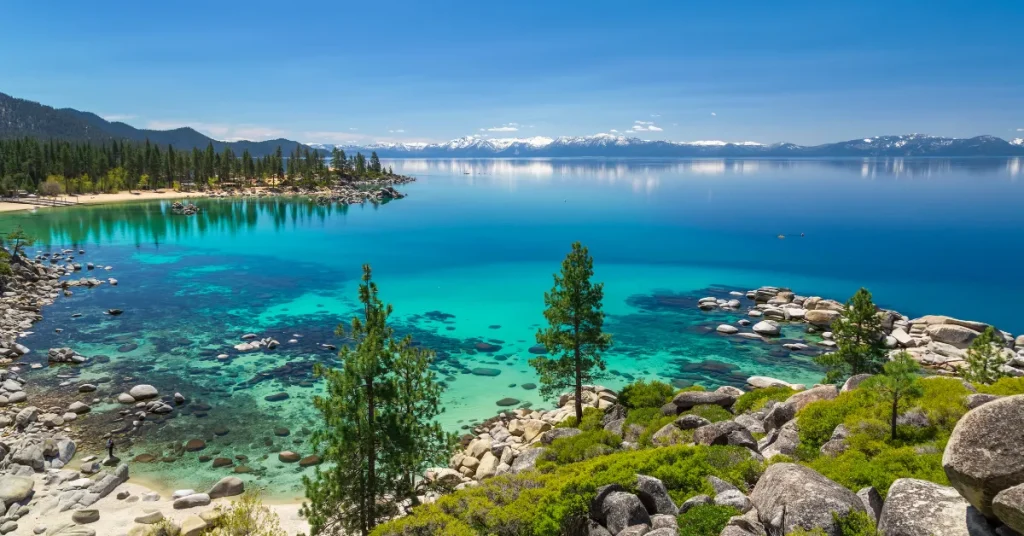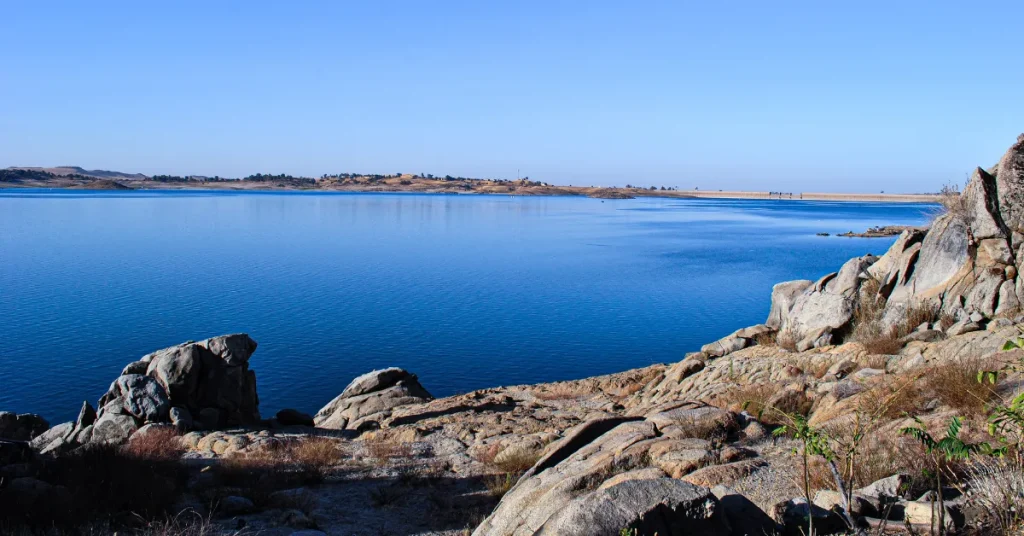Millerton Lake has a maximum depth of approximately 319 feet (97 meters). The reservoir’s depth can fluctuate based on water levels.
Nestled in the heart of California, Millerton Lake offers a scenic retreat for nature lovers and outdoor enthusiasts. Just a short drive from Fresno, this man-made lake serves both as a critical water supply and a popular recreational destination.
Anglers, boaters, and families flock to its expansive waters and surrounding parklands to enjoy a day of fun and relaxation.
With the Sierra Nevada mountains as its backdrop, Millerton Lake provides a picturesque setting for a variety of activities, including fishing, swimming, and hiking.
Its practical importance, coupled with its recreational appeal, make Millerton Lake a vital component of the region’s environmental and social landscape.

Millerton Lake’s Geological Story
Uncovering the depths of Millerton Lake reveals a fascinating geological tale. Amid the sweeping landscapes of California, this man-made reservoir serves as a vital water source and a historical treasure trove.
The lake’s origin and historic relevance weave into the fabric of California’s environmental and cultural heritage.
The Formation Of Millerton Lake
Millerton Lake took shape with the completion of Friant Dam in 1944. Its creation emerged from the need for water conservation and flood control. Here’s a quick look at the geological process behind its formation:
- Plate tectonics: Shifts in the Earth’s crust set the stage for the lake’s basin.
- Erosion: Water and wind sculpted the valley over millennia.
- Construction: Human engineering harnessed the San Joaquin River with Friant Dam, filling the basin to form Millerton Lake.
Today, Millerton Lake reaches depths that reflect its rich geological history, with areas plunging significantly below the surface. The dam’s elevation at 319 feet, coupled with the fluctuating water levels, can lead to a diversified depth profile.
Historical Significance In California
As a cornerstone of the Central Valley Project, Millerton Lake holds a special place in California’s annals. Its historical milestones include:
- Water resource for agriculture and communities.
- Flood protection for the fertile Central Valley.
- Archaeological site for Native American artifacts.
Historical records indicate that Millerton Lake encompassed Millerton town before the water rose. The submerged town adds a layer of intrigue to the lake’s historical significance.
Reservoirs like Millerton Lake demonstrate California’s intricate balance of natural resource management and historical preservation.
Measuring The Depths
Discovering the true depth of Millerton Lake is an adventure that involves science and technology. It’s not just about finding the deepest point.
It’s about painting a full picture of this underwater landscape. Experts use advanced tools to measure depths of lakes. Let’s dive into the fascinating process used at Millerton Lake.
Tools And Techniques Used
To uncover the depth of Millerton Lake, specialists rely on various tools:
- Echo sounders: Devices that use sound waves to find lake bottoms.
- GPS: Global Positioning System helps in mapping the lake accurately.
- Sonar technology: Sonar uses sound propagation to navigate and detect objects underwater.
These tools work together. The echo sounder sends signals that bounce off the lake floor. The time it takes for the sound to return is how they measure depth. GPS marks the exact location of each measurement.
Challenges In Depth Measurement
Measuring the depth of Millerton Lake comes with unique challenges:
- Lake levels often change with seasons and weather patterns. This change affects the measurements.
- Sediment can build up, altering the true depth of the lake floor.
- Environmental factors, like water clarity, can impact the tools’ effectiveness.
Experts must be precise. They often take multiple measurements. The goal is to get accurate and reliable data. Continuous monitoring is essential. This practice overcomes challenges and ensures depth readings reflect the true state of Millerton Lake.
The Dynamic Nature Of Lake Depth

Millerton Lake’s depth is ever-changing. This body of water, nestled in the Sierra Nevada foothills, has a shape and size that constantly adapts to the whim of nature’s elements.
Understanding how deep Millerton Lake is involves exploring various factors that contribute to its fluctuating levels.
Seasonal Changes Affecting Depths
- Winter: The lake fills up from snowmelt and rainfall.
- Spring: Depth peaks as snow continues to melt.
- Summer: Water levels often drop due to increased usage and evaporation.
- Fall: The depth begins to reduce as the dry season sets in.
Each season paints a new picture of Millerton Lake’s depths, delighting visitors with its transforming landscape.
Impact Of Drought And Rainfall Patterns
| Drought Years | Heavy Rainfall Years |
| Water levels drop significantly.Exposed lakebed can often be seen.Fishing and boating may be affected. | Lake reaches closer to maximum capacity.Surrounding areas may become lush.Water sports and activities increase. |
As the climate shifts, so does Millerton Lake, reflecting both the bounty and scarcity brought by weather patterns.
Diving Into The Numbers
Millerton Lake, a sparkling gem nestled in the Sierra Nevada foothills, beckons adventurers to explore its watery depths. To truly appreciate its vastness, let’s plunge into the specifics of just how deep Millerton Lake stretches below its serene surface.
Recorded Depth Measurements
At its deepest point, measurements reveal that Millerton Lake plunges to depths of 210 feet. This impressive number, however, varies depending on water levels which fluctuate with seasons and rainfall.
The lake’s average depth is around 90 to 120 feet. A fascinating fact about the lake’s depths is that they can tell historians about droughts and wet seasons from the past.
| Location | Depth (feet) |
| Near Dam | 210 |
| Average Depth | 90-120 |
Comparing Depths To Other Lakes
When matched against other lakes, Millerton stands out. Here’s a quick glimpse:
- Lake Tahoe – Depths reach 1,645 feet.
- Shaver Lake – A maximum of 135 feet deep.
- Bass Lake – Tops out around 110 feet.
Compared to Lake Tahoe, Millerton Lake is shallower, yet its depths exceed those of nearby Shaver and Bass Lakes. This size makes it ideal for a variety of recreational activities, from boating to fishing.
Millerton Lake’s Ecosystem And Depth
The Millerton Lake’s Ecosystem and Depth presents a fascinating blend of natural beauty and scientific intrigue. Nestled in the heart of California, Millerton Lake serves as a haven for a diversity of species and activities.
Its varying depths impact both the aquatic life that calls it home and the enjoyment of visitors lending themselves to a host of recreational opportunities.
Interplay Of Depth With Marine Life
The depth of Millerton Lake plays a crucial role in shaping its vibrant ecosystem. Shallower areas offer sunlight penetration, which is beneficial for plant growth. These plants, in turn, support smaller fish and insects.
Deeper waters provide a cool refuge for larger fish. Different fish species occupy various depth zones, ensuring a balanced habitat. Consider these points:
- Shallow zones foster aquatic plants and small fish.
- Mid-level depths are ideal for medium-sized fish.
- Deep waters house larger, elusive fish species.
Depth variations host distinct marine communities, making the lake a dynamic environment.
Recreational Activities Influenced By Lake Depth
Depth not only dictates the biological makeup of Millerton Lake but also the recreational scene. Fishing enthusiasts find particular spots, depending on the desired catch.
Swimmers and families often gravitate toward the more predictable shallows. Here are some activities:
- Fishing: Deep water targets trophy catches.
- Swimming: Shallow perimeters allow safe family fun.
- Boating: Depth guides safe navigation and mooring spots.
Varying depths mean diverse activities for all ages to enjoy on the lake.
Future Predictions For Millerton Lake

Millerton Lake, a central feature in California, owes its allure to not just its current state but also to what the future holds.
As we look ahead, understanding the potential changes to this lake becomes crucial. Predictions often involve the consideration of several factors, including climate patterns and conservation efforts.
Effects Of Climate Change On Depth
Climate change poses a significant threat to Lake Millerton’s depth. Scientists predict shifting weather patterns may lead to:
- Varying rainfall: less predictability in wet seasons.
- Increased evaporation: warmer temperatures resulting in more water loss.
- Altered snowmelt: changing seasonal snowmelt affecting water inflow.
Together, these factors could alter the lake’s depth, with potential long-term impacts on the local ecosystem and water availability.
Conservation Efforts To Maintain Depth
To combat these changes, various conservation strategies are being implemented:
- Water usage regulations: to reduce unnecessary wastage.
- Habitat restoration projects: to sustain the health of the lake’s surroundings.
- Community engagement: increasing awareness and involvement in preservation activities.
Sustained efforts from both officials and locals aim to keep Millerton Lake thriving for generations.
FAQs About How Deep Is Millerton Lake
What Is The Maximum Depth Of Millerton Lake?
Millerton Lake reaches its greatest depth at approximately 319 feet when at full capacity. This happens during periods when water levels are managed for optimal storage.
How Does Millerton Lake’s Depth Vary Seasonally?
Seasonal rainfall and water usage cause fluctuations in Millerton Lake’s depth. During spring, melting snow from the Sierra Nevada can increase its depth, whereas water release for irrigation may lower it in the summer months.
Can You Swim In Millerton Lake’s Deeper Areas?
Swimming in Millerton Lake is allowed, but caution is advised in deeper areas. It’s best to swim in designated zones and always wear a life jacket for safety, especially in deep water.
What Factors Influence Water Levels At Millerton Lake?
Water levels at Millerton Lake are influenced by precipitation, snowmelt from upstream mountains, and consumption for irrigation and urban usage. The U. S. Bureau of Reclamation manages the water release accordingly.
Conclusion
Exploring Millerton Lake’s depths has revealed its dynamic nature and geological significance. This reservoir, a gem in California, offers both recreational delight and vital water resources. As seasons shift, so does its depth, a testament to nature’s ebb and flow.
Remember, Millerton’s waters are as deep as its rich history and as enticing as the adventures it promises.
Resources:
1.https://www.parks.ca.gov/pages/587/files/MillertonLakeSRA_CampMap2016.pdf
